Many film fans who stayed current on the latest productions were up in arms long before the film opened. Months of speculation on its content and production troubles resulted in numerous pieces written about it, although no one at all had actually seen it. A big studio making an “erotic film” was a huge deal, and naturally speculation turned toward whether the final product would be sexy, outright pornography, and/or a complete train wreck. The actual release of the film, when people finally got to see the finished product, did little to give a definitive answer. The only thing that seemed clear after the film’s wide release was that a Hollywood film centered on sex did not equal big box office. And so Stanley Kubrick’s EYES WIDE SHUT (1999, Warner Brothers) moved out of the spotlight and into infinite cinephile discussions, and no major American film studio dared to produce such a high-profile “erotic film” for well over a decade. Once they did, though, they struck gold: Sam Taylor-Johnson’s film adaptation of the E.L. James novel Fifty Shades of Grey (2015, distributed by Focus Features) opened with a commanding lead at the worldwide box office, marking the first time in a long while that a Hollywood studio had released a sex film that made both a whole lot of money and a major cultural impact.
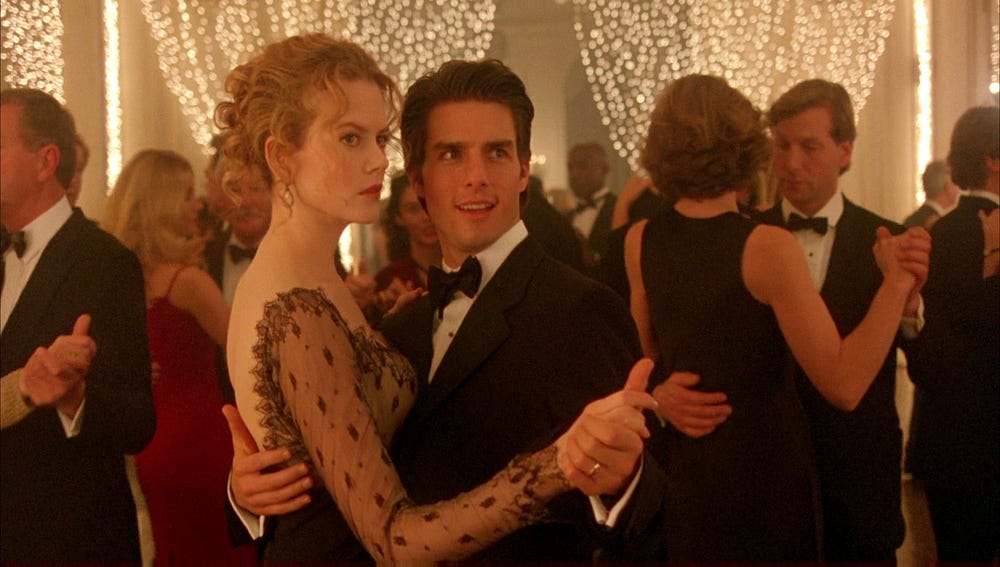
In fact, the last time an “erotic film” from a Hollywood studio made a similarly impressive showing at the American box office was in 1992 when Paul Verhoeven’s BASIC INSTINCT was released by TriStar Pictures. BASIC INSTINCT was hugely successful, ending 1992 as the fourth highest-grossing film in the world. The success of BASIC INSTINCT was in some ways the closing of a loop in that it took cues from years of low-budget independently produced erotic thrillers like Jag Mundhra’s NIGHT EYES (1990, Trimark Pictures), which in turn were inspired by the success of Adrian Lyne’s FATAL ATTRACTION (1987, Paramount Pictures). FATAL ATTRACTION proved that there was a large audience for the “erotic thriller” even in mainstream theaters. Throughout the 1980s, there were a number of adult-oriented films that left major impressions on popular culture even if they weren’t all necessarily financially successful upon their original release. These films included David Lynch’s BLUE VELVET (1986, De Laurentiis Entertainment Group), Brian De Palma’s BODY DOUBLE (1984, Columbia Pictures), Lawrence Kasdan’s BODY HEAT (1981, Warner Bros.), William Friedkin’s CRUISING (1980, United Artists), and many others. This density of films for adult audiences in the popular cultural conversation throughout the 1980s, and the subsequent virtual disappearance of any adult-oriented studio films from blockbuster-level box office success following BASIC INSTINCT — until the release of FIFTY SHADES OF GREY over twenty years later — leads to an obvious question: Why has it been so long since a major American studio made an erotic film for adults?
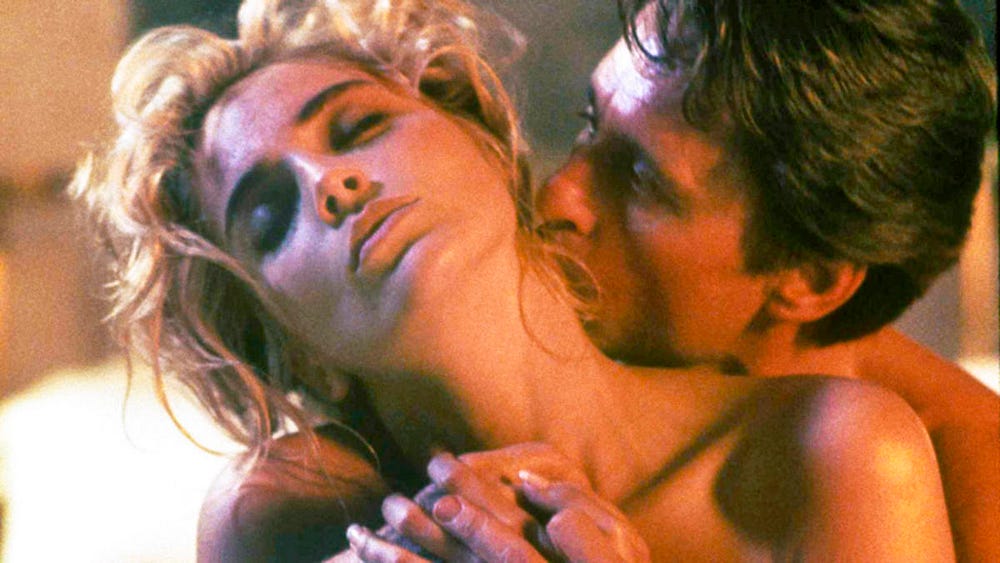
The answer goes back to the institution of the MPAA ratings system in 1968. In the late 1960s and into the 1970s, studios routinely released films made specifically for adult audiences, including erotic films that were released by the studios in part as a reaction to the increasing popularity of hardcore features made by the adult film industry. Clearly there was an audience and money to be made, especially in the wake of the massive success of Gerard Damiano’s DEEP THROAT (1972). For a short time in the 70s, hardcore features were on the verge of mainstream acceptance, to the point that the Mitchell Brothers’ BEHIND THE GREEN DOOR (1972) and other hardcore films played the Market at the Cannes Film Festival. Big-studio U.S. distributors took on films such as Bernardo Bertolucci’s LAST TANGO IN PARIS (1972, distributed by United Artists) and Just Jaekin’s EMMANUELLE (1974, distributed by Columbia Pictures) in an attempt to gain a foothold in the market for erotic cinema. In addition to such heavily sex-oriented fare, for a time after the institution of the MPAA rating system in 1968, studio pictures could carry a self-applied “X” rating to denote a film’s content was meant for adults only. Films such as John Schlesinger’s MIDNIGHT COWBOY (1969, United Artists), Russ Meyer’s BEYOND THE VALLEY OF THE DOLLS (1970, Twentieth Century Fox), and Stanley Kubrick’s A CLOCKWORK ORANGE (1971, Warner Bros.) were distributed with that rating. However, the “X” rating was not trademarked by the MPAA like the other ratings that they issued, and thus could be self-applied by anyone. This led to producers of hardcore feature films appropriating and “modifying” the rating, which caused “X” to become associated almost exclusively with hardcore pornography. Once the “X” rating was firmly established as denoting a film with pornographic content mainstream theaters refused to screen “X”-rated films, which resulted in the studios taking fewer chances on more explicit content. This drop-off in production and distribution of such films by the studios coincided with their shift toward the “Summer blockbuster” business model following the massive success of JAWS (1975) and STAR WARS (1977).
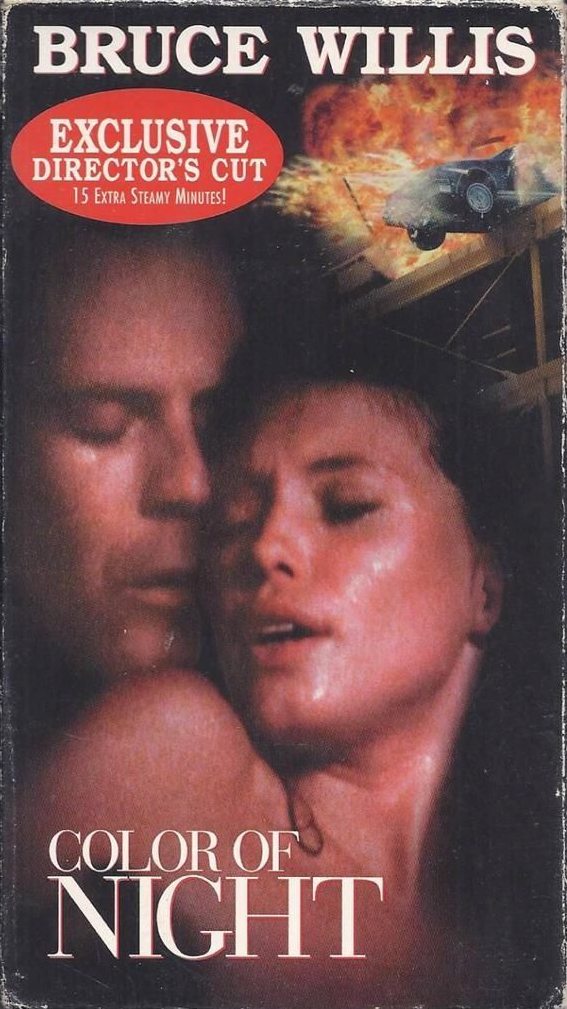
The failure of the MPAA’s rating system to create an effective “adults only” rating was famously criticized by Roger Ebert in his review of Peter Greenaway’s THE COOK, THE THIEF, HIS WIFE AND HER LOVER (1989): “We live in a country where there is no appropriate category for a serious film for adults…. And so the MPAA enters its third decade of hypocrisy, and serious filmmakers like Greenaway, filmmakers with something urgent to say and an extreme way of saying it, suffer the MPAA’s tacit censorship.” In 1990 the MPAA attempted to rectify this situation with the introduction of the new “NC-17” rating. Unlike the “X” rating, “NC-17” was trademarked by the MPAA for official use. The new rating was first applied to Philip Kaufman’s HENRY & JUNE (1990, Universal Pictures) and is still in use today, but its institution did not create a space for more adult-oriented studio films. Instead “NC-17” simply took a similar place in the view of theater owners as the “X” rating, and the frustrating history of its failure is well-documented. Studio films with notable explicit content (including BASIC INSTINCT) were frequently given an “NC-17” rating, and in most cases these films were re-cut to gain an “R” rating for theatrical release. The appearance of “unrated” and/or “director’s cut” versions of films on home video after their “R”-rated theatrical run became more and more commonplace and is now standard in home video marketing. Some high-profile erotic Hollywood films that helped to establish this practice included Uli Edel’s BODY OF EVIDENCE (1993, MGM), Phillip Noyce’s SLIVER (1993, Paramount Pictures), Richard Rush’s COLOR OF NIGHT (1994, Buena Vista Pictures), and William Friedkin’s JADE (1995, Paramount Pictures).
The failure of the major studios to make “NC-17” a workable alternative to the “X” rating was ultimately cemented with the release of Paul Verhoeven’s SHOWGIRLS (1995, United Artists). Despite sharing the same writer and director as Basic Instinct, SHOWGIRLS was released with an “NC-17” rating and was a box office disaster. This was partially due to the fact that the rating meant restrictions not just on audiences who could see the film, but on what theaters would even screen it. Further, the poor advance word about the film and an overwhelmingly negative response from critics on its original release did not help draw audiences to those few theaters where the film was showing. Regardless of the reasons for its initial failure, Hollywood had taken a clear message from the SHOWGIRLS fiasco: “NC-17” films are box office poison. While the rating is still in use, most U.S. theaters outside of smaller art house cinemas still refuse to screen “NC-17” films and generally do the same for films that do not have an MPAA rating. There have been two recent noteworthy exceptions to this unofficial policy, but both were in situations in which the distributor of the film in question also owned at least some of the theaters where the films screened: Abdellatif Kechiche’s BLUE IS THE WARMEST COLOR (2013, distributed in the States by IFC, which refused to enforce the film’s “NC-17” rating at their New York IFC Center) and Lars Von Trier’s NYMPHOMANIAC (2013, distributed unrated in the States by Magnolia, the company which owns the Landmark Theaters chain). While Ebert continued to argue throughout his career that the MPAA needed to revise its rating system to create a valid “adults only” rating, by the 2010s the studios’ almost complete lack of interest in making such films made such discussion all but pointless. Simply put, the potential profit from an “adults only” film means that from the standpoint of a Hollywood studio, making such films is usually not worth the trouble.

This is not to say that American studios did not still test the waters even after SHOWGIRLS with some occasional success. Andrew Bergman’s STRIPTEASE (1996, Columbia Pictures) stars Demi Moore as a stripper involved in a blackmail plot against a congressman (played by Burt Reynolds) and was better received by audiences than SHOWGIRLS, although critics were largely unimpressed. In 1997, New Line Cinema released Paul Thomas Anderson’s BOOGIE NIGHTS, an Altmanesque ensemble drama about the adult film industry in the 1970s and 1980s. The film was profitable and well-regarded by critics, and was nominated for three Academy Awards including Best Original Screenplay. John McNaughton’s WILD THINGS (1998, Columbia Pictures) was both a critical and box office success, inspiring three unrelated direct-to-home video sequels released long after the first film: Jack Perez’s WILD THINGS 2 (2004, Columbia TriStar Home Video), Jay Lowi’s WILD THINGS: DIAMONDS IN THE ROUGH (2005, Columbia TriStar) and Andy Hurst’s WILD THINGS: FOURSOME (2010, Sony Pictures Home Entertainment). Roger Kumble’s CRUEL INTENTIONS (1999, Columbia Pictures), was a hit largely thanks to its trio of popular young leads in Sarah Michelle Gellar, Ryan Philippe, and Reese Witherspoon, who play elaborate games of sexual manipulation in a high-school take on DANGEROUS LIAISONS. Like WILD THINGS, CRUEL INTENTIONS spawned low-budget sequels: Roger Kumble returned to direct CRUEL INTENTIONS 2 (2000, Columbia TriStar Home Video), and Scott Ziehl’s CRUEL INTENTIONS 3 (2004, Columbia TriStar Home Video) is tenuously connected to the previous films but features no returning characters from either previous entry in the series. Adrian Lyne, director of FATAL ATTRACTION, returned to the top of the box office with UNFAITHFUL in 2002, distributed by Twentieth Century Fox. UNFAITHFUL, adapted from Claude Chabrol’s THE UNFAITHFUL WIFE (1968), stars Diane Lane as a married woman who is drawn into an affair with a younger man (Olivier Martinez). Also starring Richard Gere, UNFAITHFUL was a solid hit, but the total box office take from its U.S. theatrical run was considerably less than what FIFTY SHADES OF GREY would make in the States during its opening weekend alone. Similarly, Mike Nichols’s CLOSER (2004, Columbia Pictures) was well-received by critics and performed well in the United States and even better internationally. While marketed with an emphasis on images of its star Natalie Portman playing a stripper, the film features much frank discussion of sex but no sex scenes or explicit nudity.
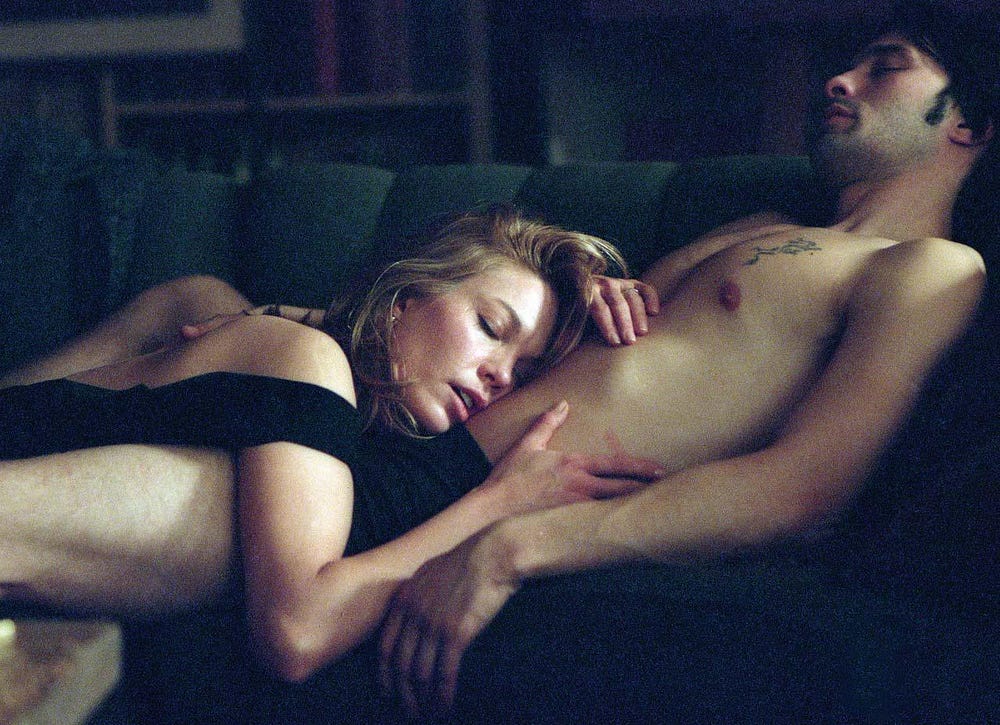
More often than not, though, studios have found that films with a strong emphasis on sex have not performed as well as expected with critics or audiences. Following the critical and commercial success of LEAVING LAS VEGAS (1995), director Mike Figgis directed the erotic drama ONE NIGHT STAND (1997, New Line). Despite its noted director and ensemble cast of well-known actors, ONE NIGHT STAND failed to replicate the success of Figgis’s previous film. Michael Christofer’s ORIGINAL SIN (2001, MGM), a remake of François Truffaut’s MISSISSIPPI MERMAID (1969), was met with derision by critics and failed to make an impression at the box office despite the promise of its stars Angelina Jolie and Antonio Banderas appearing in explicit sex scenes. KILLING ME SOFTLY (2002, MGM), the English-language debut of Chinese director Kaige Chen, starred Heather Graham and Joseph Fiennes in an erotic thriller that hews closely to the ’90s softcore style. KILLING ME SOFTLY received negative reviews and was a non-starter at the box office. Brian De Palma, who had made popular adult studio films such as DRESSED TO KILL (1980, Filmways Pictures) and BODY DOUBLE (1984, Columbia Pictures), returned to the genre with FEMME FATALE in 2002 (distributed by Warner Bros.). On its release, FEMME FATALE received mixed reviews and was ignored by audiences, although it has since gained a cult following and critical reassessment. Jane Campion’s IN THE CUT (2003, Screen Gems) is a gruesome erotic thriller bordering on horror and marked a serious departure for star Meg Ryan, previously known best for popular romantic comedies. Much was made of her nude scenes in the film, but the curiosity to see a big female star in such a risqué role was not enough to draw audiences. Universal Pictures distributed Fenton Bailey and Randy Barbato’s documentary INSIDE DEEP THROAT in 2005, and while the film was critically acclaimed, its “NC-17” rating prevented most audiences from being able to see the film during its theatrical run. Perhaps the biggest deterrent to studios later considering production of a high-profile erotic film was the reception of Michael Caton-Jones’s BASIC INSTINCT 2 (2006, Columbia Pictures). Despite being a sequel to a blockbuster and bringing that film’s star Sharon Stone back to reprise her signature role, BASIC INSTINCT 2 was eviscerated by critics and a spectacular failure at the box office.
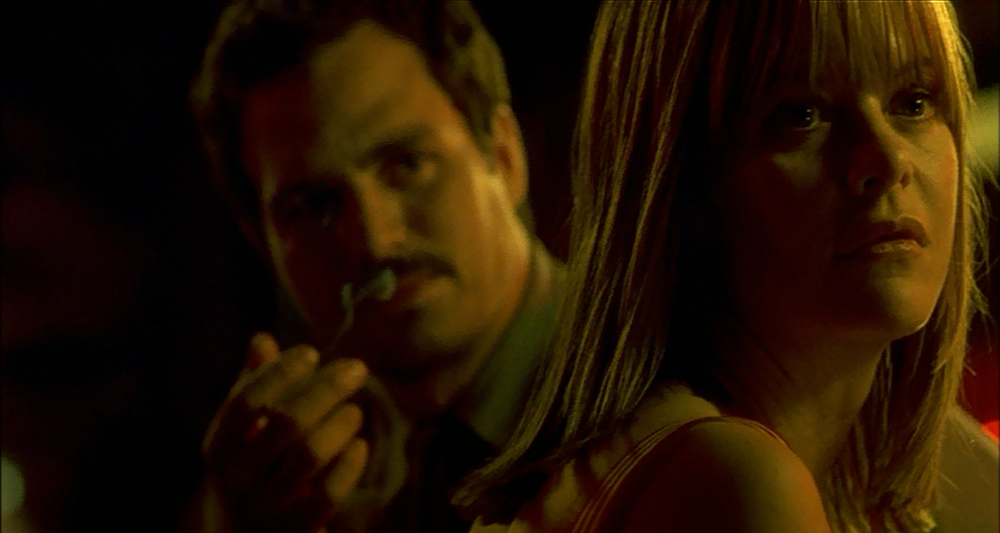
And so while it should have been obvious that a FIFTY SHADES OF GREY film would be a hit, it hardly seemed like a sure thing given the track record of erotic studio films following BASIC INSTINCT. The three Fifty Shades books sold millions of copies, virtually guaranteeing a screen adaptation. What presented a problem with the property from the viewpoint of Universal Pictures was that unlike other such contemporary popular literary franchises as Harry Potter and The Hunger Games, these books were written for and marketed directly to adults. Furthermore the books were extremely popular with adult women. This made the film adaptation something of a gamble, as major studios have come to rely on “tentpole” blockbusters to remain profitable. These films are currently dominated by comic book adaptations and other franchises overtly made to appeal to a primarily young male audience or to capitalize on older male audiences’ nostalgia (such as the TRANSFORMERS films). Despite the very different nature of FIFTY SHADES OF GREY from other A-list franchises—highly sexual, directly aimed at women, marketed to adults—and over two decades having passed since the last major-studio erotic blockbuster, the film became the fastest-selling R-rated film ever on movie ticket site Fandango when tickets went on sale a month before the film’s opening weekend. The film opened at the top of the U.S. box office for the week of its release, and was notable for being the fourth-biggest opening ever for an R-rated film and the second-biggest opening weekend for a film by a female director. Clearly, at least part of whatever allure the books held for their audience had carried over as interest in the film adaptation despite the fact that its sexual content was severely toned down in its transition to the screen.
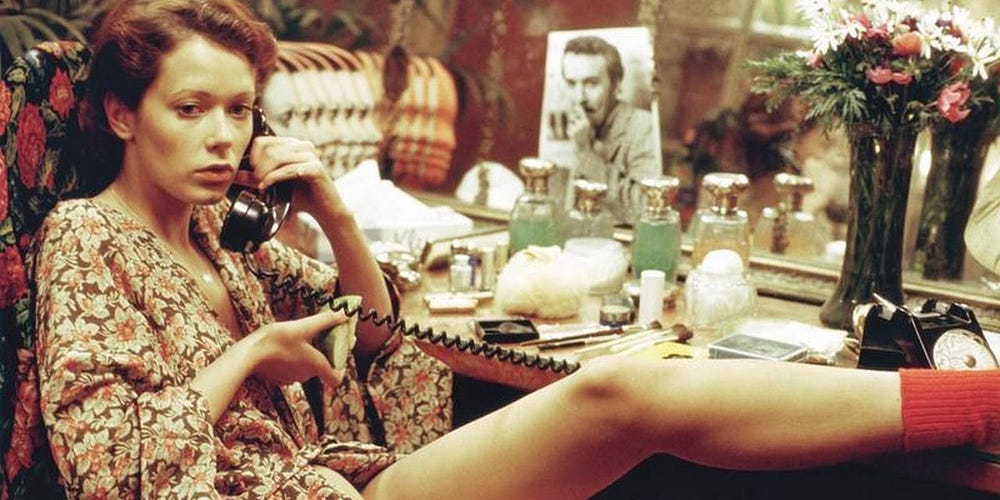
Comparing FIFTY SHADES OF GREY to previous hit erotic films produced and/or distributed by major American studios, its nearest kin is Just Jaekin’s adaptation of Emmanuelle Arsan’s novel Emmanuelle (1974). Both films are derived from novels concerned with a female character exploring her sexuality, although they are very different takes on this basic concept. The title character of EMMANUELLE (Sylvia Kristel) is educated, wealthy, and already sexually experienced at the start of the film. FIFTY SHADES OF GREY’s Anastasia Steele (Dakota Johnson) is a young, self-conscious, working-class virgin. Emmanuelle lives in a world of opulence, flying to Bangkok to see her wealthy husband and indulge in various erotic adventures, while Anastasia is ushered into a life of luxury as well as one of sexual awakening. Rich characters are common throughout erotic cinema, from bigger productions like Just Jaekin’s LADY CHATTERLY’S LOVER (1981, Cannon Films) to lower-budget films like the aforementioned NIGHT EYES (1990). Radley Metzger, a legendary filmmaker in the history of adult cinema whose own films frequently depicted upper-class characters, addressed the preponderance of wealth and opulence in erotic films in an interview with Mondo Digital: “In the area of eroticism, I think it’s easier to involve the audience if you deal with rich people. When you try to create total environments, you don’t want to deal with the question of how your characters make a living. So I had to keep everything very upscale. It’s a kind of seduction. I think audiences can be more accepting of a film if the atmosphere is different from their own.” EMMANUELLE was a worldwide box-office success, but more importantly its impact on popular culture has been long-reaching and vast, spawning a number of official and unofficial sequels and spin-offs in feature films and cable TV series. In the official series produced by Alain Siritzky, the character has been played by Monique Gabrielle (EMMANUELLE 5, 1987), Natalie Uher (EMMANUELLE 6, 1988), Marcela Walerstein (as “Young Emmanuelle” in a six-film series from 1993 featuring Kristel as “Old Emmanuelle”), Krista Allen (the EMMANUELLE IN SPACE series), Holly Sampson(the EMMANUELLE 2000 series), Ludmilla Ferraz (EMMANUELLE IN RIO, 2003), Natasja Vermeer (the EMMANUELLE: THE PRIVATE COLLECTION series), and Allie Haze (the EMMANUELLE THROUGH TIME series).
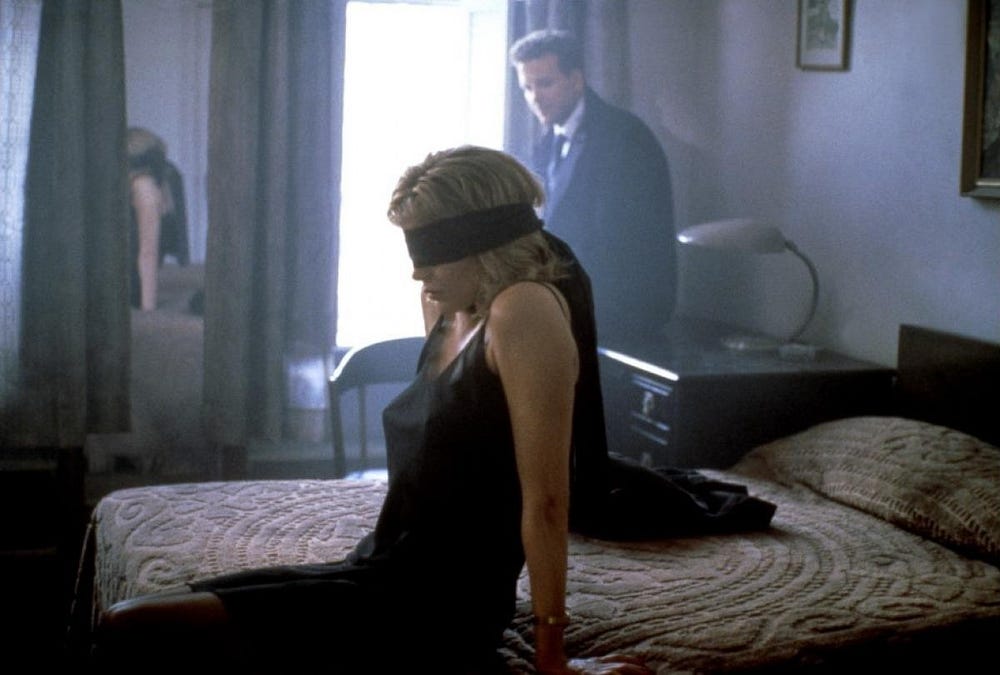
Removing the condition of box-office success, the previous major-studio sex film closest in form and content to FIFTY SHADES OF GREY is Adrian Lyne’s adaptation of Elizabeth McNeill’s novel Nine 1/2 Weeks (1986, MGM). A notorious flop when originally released with an “R” rating, the film later found an audience when the unrated version was released on home video and cable TV. The storyline of NINE 1/2 WEEKS is curiously similar to that of FIFTY SHADES OF GREY: Divorced Elizabeth (Kim Basinger) strikes up a torrid affair with John Gray (Mickey Rourke), a wealthy man with sadomasochistic proclivities. Also notable is the fact that both films end with their female protagonist leaving their lover. Unlike NINE 1/2 WEEKS , though, there are two more books of “Fifty Shades” source material, and so the story will presumably continue with further films. NINE 1/2 WEEKS was followed by two sequels in the late 1990s. Anne Goursad’s ANOTHER NINE & A HALF WEEKS (1997, Lionsgate Home Entertainment) featured Mickey Rourke reprising the role of John Gray playing opposite new female lead Angie Everhart. Alex Wright’s THE FIRST 9 1/2 WEEKS (1998, Lions Gate Films) is unrelated to the previous two films, starring Paul Mercurio as a banker who becomes involved with the wife (Clara Bellar) of a Louisiana millionaire (Malcom McDowell). Zalman King, a producer and co-writer of the screenplay for the original NINE 1/2 WEEKS , went on to direct a number of softcore films such as TWO MOON JUNCTION (1988, Lorimar Motion Pictures), WILD ORCHID (1989, Triumph Releasing Corporation), and DELTA OF VENUS (1995, Fine Line Features). King’s work is an obvious influence in look and tone for FIFTY SHADES OF GREY, both in his films and in The Red Shoe Diaries, an erotic television series he created which ran for five seasons on the pay cable channel Showtime from 1992 through 1997.
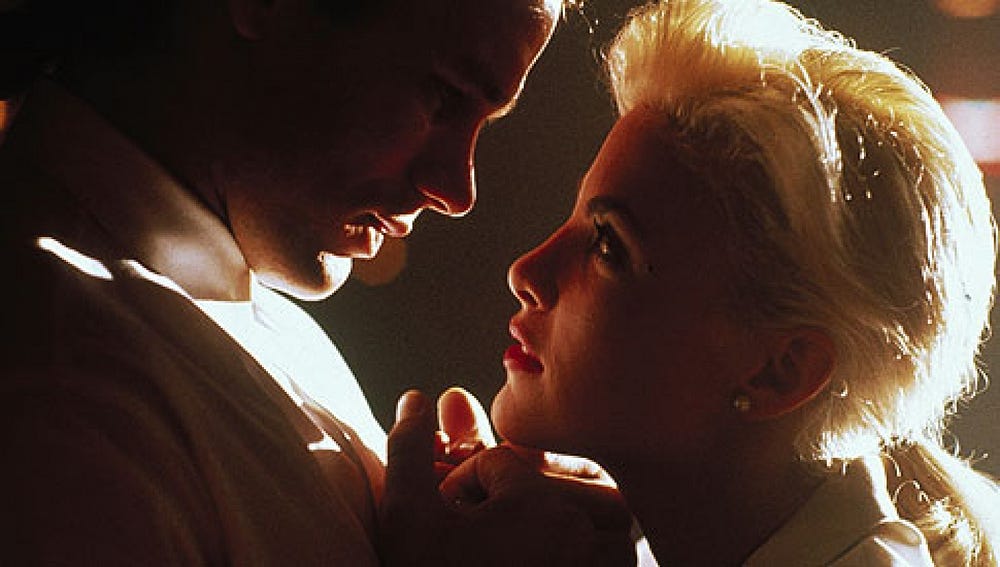
King, who disliked the term “softcore” used to describe his work, recognized the importance of his female audience and tailored his films with a female viewer in mind: “…the films are basically directed at women. And I do it consciously, which you can see in ‘Red Shoe Diaries.’ The entire series was directed at women. Men watch it because it’s sexy, but consistently it is about relationships and it is about women struggling with their identity and having romance…. I think maybe I do this because there is very little for them in terms of cinema and in terms of this ‘high romance.’” King also had actual viewer data for The Red Shoe Diaries that confirmed his belief: “…for sure the TV shows are 60/40 female/male viewership, from Showtime….” The fact that King knew he had a large audience of female viewers is interesting, not least because it appears that his observations regarding female audiences and their interest in seeing stories about “relationships” and “women struggling with their identity” are directly applicable to the success of FIFTY SHADES OF GREY. Despite its big-budget slickness, there is no question that FIFTY SHADES OF GREY looks and feels somewhat like a Zalman King film or a very expensive, extended episode of The Red Shoe Diaries. The film spends plenty of time with its characters out of the bedroom before moving into its sex scenes. These scenes are carefully blocked and shot to prevent any question of whether the line between “softcore” and “hardcore” is crossed, and there is plentiful male and female nudity. Like The Red Shoe Diaries and King’s erotic films, FIFTY SHADES OF GREY is about Anastaia “struggling with her identity,” and like those films the camera spends a lot of time lingering on her face, giving the viewer a close look at how she processes the new world of opulence and sexuality into which she is being initiated. During the sex scenes, there is also a clear focus on her pleasure, as in the now iconic shot included in the film’s trailer of Anastasia, blindfolded, leaning her head back and gasping in ecstasy.
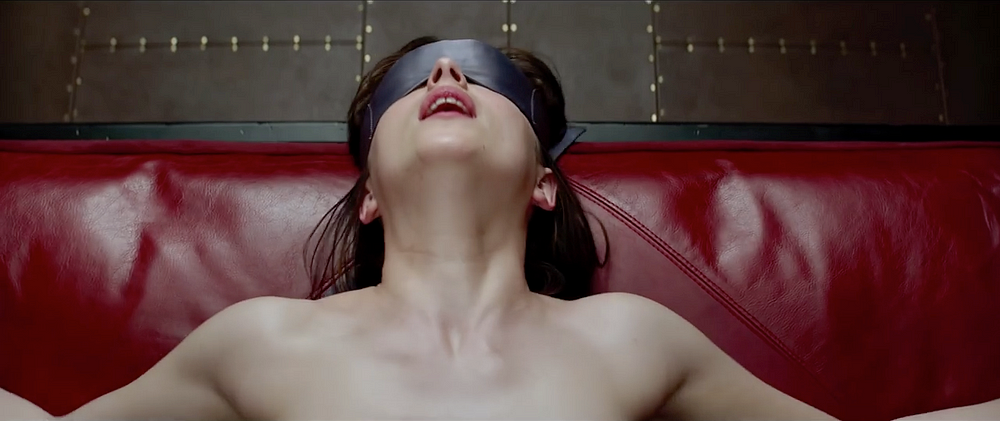
The principal content that sets FIFTY SHADES OF GREY apart from previous Hollywood softcore films is its focus on BDSM. Christian Grey introduces Anastasia to his “Red Room of Pain” early in the film, but afterward the couple spends very little time there. Most of the sex scenes are fairly typical of traditional softcore, with the addition of some light bondage aspects. In two separate bedroom scenes, Christian holds or ties Anastasia’s hands up over her head, and in one he also blindfolds her and rubs an ice cube over her body. It is only as the film moves toward its last half that there is an extended sequence in the “Red Room,” and this scene is very much concerned with how much Anastasia is enjoying herself as she explores her newfound sexuality. For her part, Dakota Johnson portrays the character of Anastasia ably, and even though Jamie Dornan’s Christian comes across as something of a robotic sociopath (admittedly it is difficult to imagine how any actor would make this character interesting), Anastasia is depicted as interested and enthusiastic about pursuing a sexual relationship with him. Director Sam Taylor-Johnson shoots the sexual encounters in a manner similar to traditional softcore (albeit without the soft focus that is often associated with the style), including the slightly more involved encounters in the “Red Room” which include the use of restraints, rope, a riding crop and a flogger. Unfortunately, despite presenting the sex as something genuinely pleasurable to both parties, the film ultimately insists on treating an interest in BDSM as abnormal, and strongly suggests that it has arisen for Christian as a result of childhood trauma. Thus the film follows another familiar pattern of softcore films: presenting taboo sexual activities (infidelity, masturbation, lesbianism, group sex, BDSM, etc.) as exciting, appealing, and highly satisfying, while at the same time condemning them as “strange” or “deviant.” Here is where FIFTY SHADES OF GREY and the “erotic thriller” dovetail with the subtext of much modern horror cinema, as described by Robin Wood in his book Hollywood from Vietnam to Reagan, which is often concerned with “the restoration of the traditional order….” (121) and “fear of the release of repressed sexuality” (150). Many erotic thrillers allow their heroine to explore repressed desires and partake in sexual adventures, but they also almost always end with their return to a husband or partner, restoring the “traditional order.” In this respect, FIFTY SHADES OF GREY fits neatly into the canon of mainstream American softcore cinema.
FIFTY SHADES OF GREY also fulfilled a similar role to previous Hollywood studio sex film hits in that it inspired a handful of films either specifically produced for or conveniently released to capitalize on its potential success. Billie Woodruff’s ADDICTED (2014, Lionsgate), an adaptation of an erotic novel by best-selling author Zane, was probably the first film made specifically to take advantage of the impending release of the FIFTY SHADES film. The film’s press kit made a point to compare the two, claiming that ADDICTED made “FIFTY SHADES OF GREY look tame….” ADDICTED follows the descent of successful career woman and seemingly happy housewife Zoe (Sharon Leal) who “suffers” from an insatiable sex drive. This causes her to strike up extramarital affairs with a sensual artist (William Levy) and a motorcycle-riding bad boy (Tyson Beckford) despite having an active sex life with her husband (Boris Kodjoe). ADDICTED moves somewhat into erotic thriller territory as Zoe’s life spins out of control due to her sex addiction. Its typically neat finale finds Zoe restored to her place in her family after her sex addiction is explained by the unveiling of a traumatic sexual experience from her past. Much more in the vein of the standard erotic thriller/stalker movie is Rob Cohen’s THE BOY NEXT DOOR (2015, Universal Pictures). This film stars Jennifer Lopez in a clear throwback to the endless FATAL ATTRACTION knock-offs of the ’80s and ’90s. Lopez plays a high school English teacher named Claire, separated from her husband following his infidelity, who has a sexual encounter with a young man named Noah (Ryan Guzman) who has moved into her neighborhood to take care of his grandfather. Following their tryst, Noah becomes dangerously obsessed with Claire. He engages in increasingly threatening behavior that eventually forces her into a violent confrontation. Both ADDICTED and THE BOY NEXT DOOR were modest hits, and interestingly both films were aimed at fairly specific audiences: THE BOY NEXT DOOR was marketed largely to Latinos, while Zane, the author of the novel on which ADDICTED was based, is a best-selling author in African-American fiction.
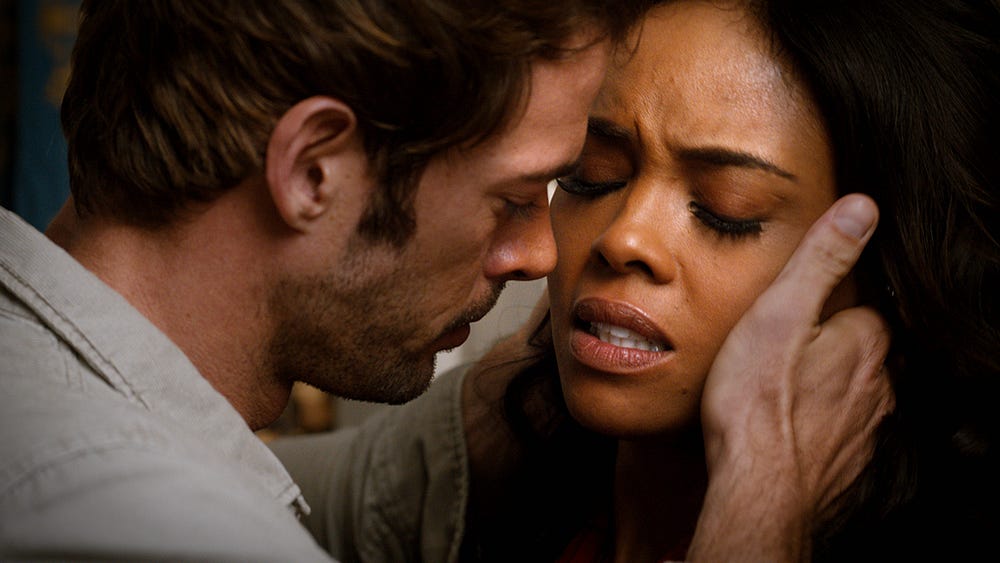
Two films that were indisputably produced to capitalize on the release of FIFTY SHADES OF GREY are Jared Cohn’s BOUND (2015) and Rik Swartzwelder’s OLD FASHIONED (2014, Freestyle Releasing). BOUND was produced and distributed by The Asylum, a low-budget production company specializing in “mockbusters”: low-budget versions of popular franchises, such as TRANSMORPHERS. BOUND was blatantly marketed as a similar take on FIFTY SHADES OF GREY’s novel focus on BDSM. Charisma Carpenter stars as Michelle, a self-conscious divorcee who works for her father (Daniel Baldwin) at a commercial real estate firm. She is seduced by a younger man named Ryan (Bryce Draper), a ruthless dominant and known predator in the local BDSM scene. Ryan turns violent when Michelle shows an interest in taking a more dominant role in their relationship, but with the support of a friendly dominatrix (Hayley McLaughlin) Michelle discovers she’s been on “the wrong side of the whip.” Her confidence soars after she takes revenge by sexually humiliating Ryan and breaks off their relationship. Curiously, BOUND is the only one of the softcore films released alongside FIFTY SHADES OF GREY that ends with its female protagonist embracing her newfound sexuality and gaining self-confidence from it that she can apply to the rest of her life. This makes it a rare exception to the rule about the softcore film restoring “the traditional order.” On the exact opposite end of the spectrum, OLD FASHIONED is a Christian film released in theaters the same day as FIFTY SHADES OF GREY as a direct response and challenge to that film. OLD FASHIONED stars writer/director Rik Swartzwelder as former amateur pornographer Clay, who has transitioned into quiet small-town life after finding Jesus. When free-spirited Amber (Elizabeth Roberts) moves into the apartment above Clay’s antique store, Clay and Amber find themselves attracted to each other. But Clay is unsure how to pursue a relationship given his intense personal standards, which include never being in a room alone with a woman until he’s married. As a small independent production, OLD FASHIONED opened with a surprising $1 million on 200 screens, but it was hardly the serious challenge to FIFTY SHADES OF GREY (which opened on over 3,600 screens) for which its producers had supposedly hoped.
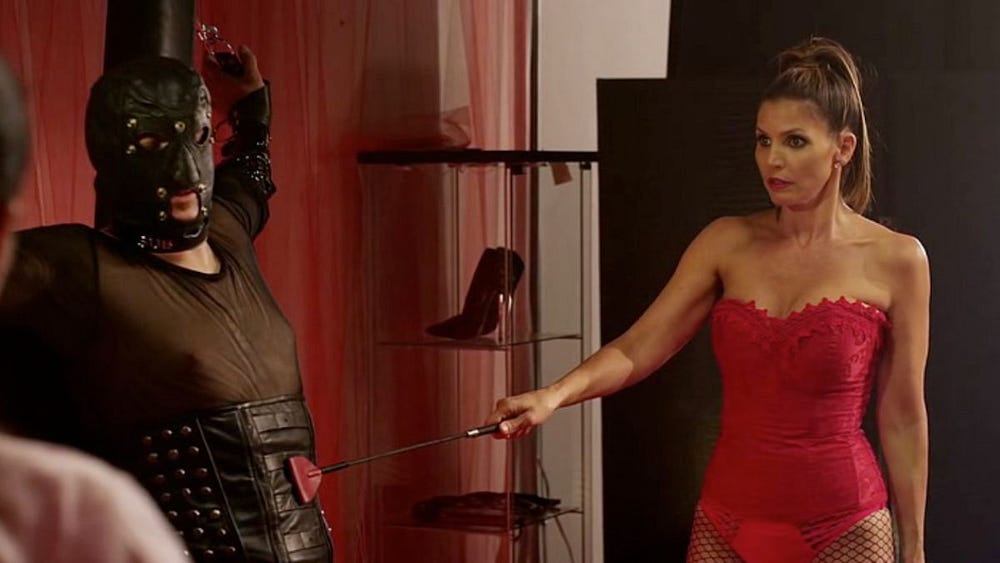
A final film that was possibly released to capitalize on the “Fifty Shades” hype was Erik Van Looy’s THE LOFT (2014, Open Road Films). A remake of the same director’s 2008 Belgian film LOFT, the English version was shot in 2011 but not released until January of 2015. This was at least partially due to typical big-studio maneuvering, but the marketing of the film emphasized its sexual content, and its release just a few weeks before FIFTY SHADES OF GREY makes it seem likely Universal was attempting to cash in. Perhaps unsurprisingly this did not work, as THE LOFT opened to extremely weak box office. If it was indeed released to take advantage of the hype surrounding FIFTY SHADES OF GREY, there is at least one very obvious difference between it and ADDICTED, BOUND, and THE BOY NEXT DOOR: instead of a single female protagonist, THE LOFT centers on a cast of male characters. If the hope was to offer a “male alternative” to the female-centric films released around the same time, THE LOFT’s box office performance seemed to indicate the audience for such a thing was basically non-existent.
Whether or not the success of FIFTY SHADES OF GREY signals a return of the big-budget erotic studio film remains an open question. Despite its blockbuster opening weekend, Universal initially seemed curiously hesitant to publicly commit to putting sequels in production. This may be due in part to reported clashes between the film’s director Sam Taylor-Johnson and the author of the “Fifty Shades” novels E.L. James, who was given an unprecedented level of control over the film adaptation of her book as an on-set consultant. The film’s quick drop-off in box office after its huge opening weekend only added to the uncertainty, and Taylor-Johnson has since confirmed that she will not return to direct further installments in the franchise. In a climate where hit comic book adaptations immediately have multiple sequels announced at the first hint of box office success, Universal’s timidity regarding putting “Fifty Shades” sequels into production was troubling. Still, there will almost certainly be a number of low-budget films riding the residual wave of hype from FIFTY SHADES OF GREY, although most of these will probably go direct to home video and VOD. Since the “Fifty Shades” phenomenon reached critical mass with the publication of the books in 2012, independent producers have already released films such as Inside the Fifty Shades: Real Women Confess (2013, New Conquest Pictures). Some home video companies have also taken advantage of the success of the novels and film to repackage older films for new audiences, such as Blue Underground’s “Fifty Shades of de Sade” set, Echo Bridge Home Entertainment’s “Guilty Pleasures” set, and Mill Creek Entertainment’s “7 Shades of Sexy” collection. It seems likely there will be more such reissues hitting shelves in the near future, similar to the boom in home video releases of “grindhouse” films following Quentin Tarantino and Robert Rodriguez’s GRINDHOUSE (2007). As for the big screen, one can only hope that Universal and its competitors will take the success of FIFTY SHADES OF GREY as a clear indicator that female audiences will show up in large numbers when a film is tailored specifically for them. And hopefully it won’t be another two decades before another blockbuster erotic film made for adults finds its way into theaters.
- [CINEPOCALYPSE 2017] FIVE FILMS YOU CAN’T MISS AT CINEPOCALYPSE! - October 31, 2017
- Hop into Jason’s Ride for a Look at the Wild World of Vansploitation! - August 11, 2014
Tags: Abdellatif Kechiche, Adrian Lyne, Angelina Jolie, Antonio Banderas, Bernardo Bertolucci, Boris Kodjoe, brian de palma, Bruce Willis, Burt Reynolds, Cannon Films, Charisma Carpenter, Claude Chabrol, Dakota Johnson, David Lynch, Demi Moore, Diane Lane, E.L. James, Elizabeth Berkley, François Truffaut, Gerard Damiano, Heather Graham, Jamie Dornan, Jane Campion, Jane March, Jennifer Lopez, Joe Eszterhas, John McNaughton, John Schlesinger, Joseph Fiennes, Just Jaekin, Kaige Chen, Kim Basinger, Krista Allen, Kyle McLachlan, Lars Von Trier, Lawrence Kasdan, Malcom McDowell, Mark Ruffalo, Meg Ryan, Michael Caton-Jones, Michael Douglas, Mickey Rourke, Mike Figgis, Mike Nichols, Monique Gabrielle, Natalie Portman, Nicole Kidman, Olivier Martinez, Paul Thomas Anderson, Paul Verhoeven, Peter Greenaway, Philip Kaufman, Phillip Noyce, Radley Metzger, Reese Witherspoon, Richard Rush, Richard Tyson, Rob Cohen, Roger Kumble, russ meyer, Ryan Philippe, Sam Taylor-Johnson, Sarah Michelle Gellar, Sharon Leal, Sharon Stone, Sherylin Fenn, Softcore Week, Stanley Kubrick, Sylvia Kristel, the asylum, tom cruise, Uli Edel, William Friedkin, zalman king




No Comments